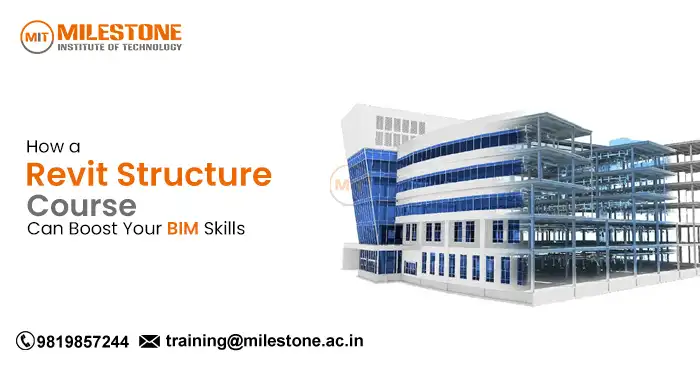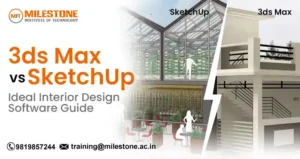
In today’s design and construction industry, Building Information Modeling (BIM) has completely changed the way engineers and designers work together. It promotes accuracy, collaboration, and efficient advancement of projects. Revit Structure is one of the most widely used design tools that continues to support this revolutionary trend in the industry. In fact, on-site exposure to a professional Revit Structure course can help improve your design competencies, develop your technical skills and overall BIM capacity.
This blog will assist you in understanding how a Revit Structure course enhances your BIM skills, fosters your career growth, and propels your workforce potential in a highly competitive construction industry.
Understanding Revit Structure
Revit Structure is a specialized BIM platform designed for structural engineers and designers and provided by Autodesk. It enables the design of 3D models of components such as beams, columns, foundations, and slabs of buildings accurately. Together with architectural and MEP systems, Revit Structure links cohesively and allows multiple teams to work together productively.
The aim of the Revit Structure course is to prepare you to start using Revit Structure, learning the process of drafting from modeling to embedding structural data. You will learn to create realistic models that can embed project data such as materials, quantities, and cost information. This will help develop your efficiency and accuracy when analyzing complex BIM projects.
Why BIM Skills Are Essential Today
BIM has become the backbone of construction in the modern area. It allows professionals to collaborate on intelligent 3D models complete with data to analyze and manage the project. It helps to reduce design issues, complete tasks more efficiently, and ensure easy collaboration among all project teams.
The Revit Structure course teaches students to utilize the principles of BIM, as well as an understanding of how BIM supports sustainability, cost savings, and visualization for the project. Being proficient in Revit Structure enables you to add operational value as part of a BIM project based on digital delivery.
How a Revit Structure Course Improves Your BIM Skills
Real-World 3D Modeling Experience
When you enroll in a Revit Structure course, you will participate in a workshop that allows you to create a developed 3D model. You’ll learn how to design and edit structural components, apply loads, and visualize the total building structure. Your training is meant to fully prepare you for real-world performance.Improve Collaboration and Coordination
You will learn to manage linked models and shared work environments through a Revit Structure course. Revit’s collaborative platform allows different disciplines to work on the same project at the same time. You will master the coordination process which lessens design conflicts and improves workflow.Structural Analysis Integration
As advanced Revit Structure courses require integration of your models with analysis tools in order to analyze loads and material strengths. This advancement will ensure your design follows safety specifications and is cost effective.Automatic Documentation and Reporting
With supervised training, you will learn to automatically generate drawings, material schedules, and documentation with accuracy. The automatic documentation will bring you fewer manual mistakes and will save you time. Finally, you will learn how to create templates and manage annotations.Decreased Design Mistakes and Enhanced Precision
Taking a Revit Structure course takes advantage of BIM’s ability to organize and identify distinct clashes and inconsistencies early in the design process, which will help to minimize unnecessary costly amendments during construction and improve accuracy across the project.Greater Efficiency and Productivity
You will learn how to automate repetitive tasks to become more efficient through parametric modeling and family creation, allowing for greater speed and quality on a significant project.Certification and Career Advancement
A Revit Structure course is credited with proving that you are certified in the subject matter. Certified professionals are more likely to be recruited among the top engineering or construction firms. It adds credibility to your portfolio and opens doors for jobs both locally and internationally.Key Benefits of Learning Revit Structure
- Improved project visualization using smart 3D models
- Accurate cost and material estimation
- Stitching teams through shared models
- Identifying errors and optimizing design early
- Automation that saves time for faster completion of projects
- Sustainable design practices that align with global BIM standards
Career Opportunities After Completing a Revit Structure Course
Completing a Revit Structure course can help you become a BIM modeler, structural designer, design engineer, technical engineer, or a BIM coordinator. These roles are highly sought-after in many sectors, including real estate, infrastructure, and architecture.
Revit Structure skills are valued worldwide. Engineers who are trained in Revit Structure can work on international projects, as many developed economies have implemented BIM technology into their design and engineering workflows. The knowledge gained through a Revit Structure course will enhance your technical skills, as well as broaden your employment opportunities internationally.
Conclusion
One of the best ways to learn BIM tools and develop your skillset as a structural designer is to take a Revit Structure course. You will learn about all the facets of digital modeling, documentation, and analysis, while improving collaboration and productivity on your projects. As the construction industry embraces BIM technology, your knowledge of Revit Structure will provide a competitive advantage.
If you want to positively influence the future of building design, it is the perfect time to take a Revit Structure course. You will be able to take your BIM skills to the next level and create a successful and fulfilling career in structural design and engineering with the right education and support.Frequently Asked Questions
What are the benefits of BIM training?
- BIM training allows for better collaboration, efficiency, and accuracy within construction projects through better management of digital design, coordination, and project management.
How can a Revit Structure course help in BIM?
- It allows you to create detailed 3D models of structure and work seamlessly in BIM projects.
Is Revit Structure important for BIM professionals?
- Yes, it’s essential as it helps create accurate, information-rich structural models for integrated BIM workflows.
What industries benefit most from learning Revit Structure?
- Architecture, engineering, and construction industries gain accuracy, collaboration, and better project outcomes.



